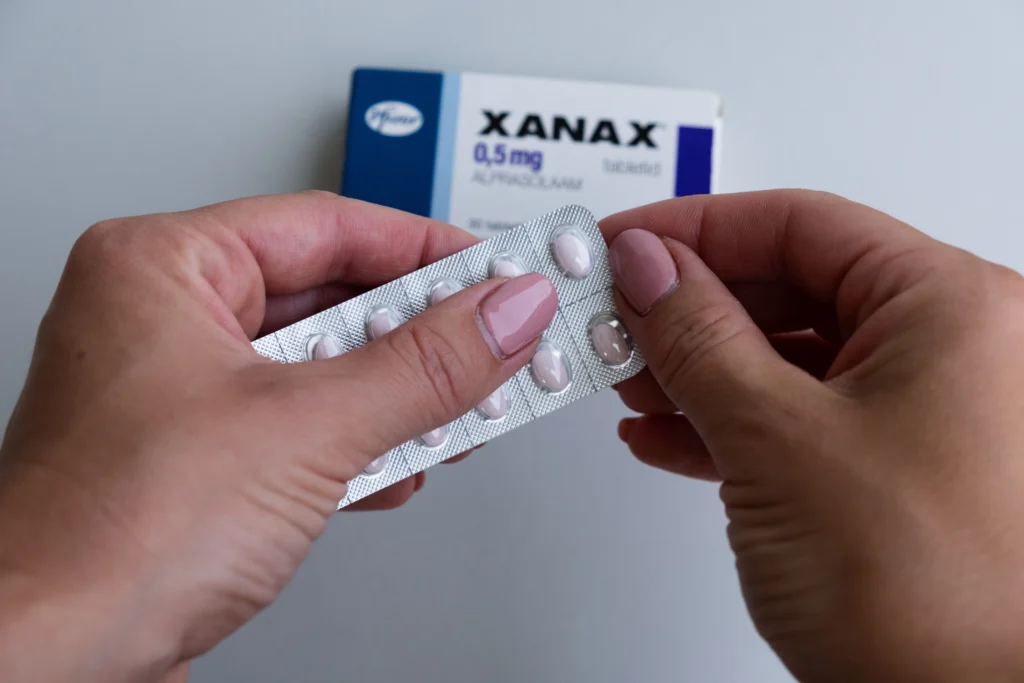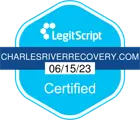The Hidden Epidemic of Prescription Drug Abuse
Xanax is a powerful benzodiazepine that is often prescribed to treat sleeplessness, panic disorders, generalized anxiety disorder (GAD), and similar problems. Despite its therapeutic benefits, its high potential for addiction and abuse makes Xanax a cause for serious concern.
In 2021, roughly 14% of opioid overdose deaths also involved benzodiazepines. Xanax users rapidly develop a tolerance, needing higher doses to obtain the intended results. Individuals addicted to Xanax may take up to 30 pills a day.
Efforts to cease substance use may reveal withdrawal symptoms such as anxiety, anxiousness, insomnia, and palpitations, which indicate the development of physical dependence, a fundamental characteristic of addiction.
Once Xanax addiction takes hold, it changes a person’s priorities, taking focus away from things like education, jobs, and family. Instead, individuals engage in obsessive drug searching. Recognizing addictive behavioral indications and symptoms is critical.
The Chemistry Behind Xanax Addiction
Benzodiazepines are central nervous system depressants that inhibit brain activity. Xanax functions by explicitly increasing the activity of gamma-aminobutyric acid (GABA), a chemical in the brain. GABA is a neurotransmitter that inhibits communication between neurons in the body and dampens neural excitation. When this occurs, users may encounter any or all of the following:
- Decreased anxiety and stress
- Drowsiness
- A decline in coordination
- Impaired/defective judgment
Similar to opioid substances like oxycodone, Xanax induces addiction and alters neuron signaling throughout the brain, increasing dopamine release. Dopamine is an endogenous chemical intrinsically linked to sensations of gratification and relaxation. An elevated dopamine surge, such as that experienced during certain drug use, can potentially induce an intense high that reinforces the inclination toward continued drug consumption.
Medical and mental health professionals commonly refer to Xanax addiction as anxiolytic use disorder. The affected person requires a higher dosage to achieve the intended effect, and the drug’s effect is diminished when the same quantity is administered.
Xanax Tolerance
Certain individuals develop a tolerance to Xanax when the medication is administered for prolonged periods or at elevated dosages. This may occur despite the client following the doctor’s prescribed dosage.
Tolerance may begin rapidly or set in slowly based on the dosage, how someone metabolizes the drug, and to what extent they are taking other medications. Tolerance develops in most individuals within days to weeks of consistent use.
Physical dependence on Xanax is frequently accompanied by tolerance to the drug, which further complicates the cessation process by introducing withdrawal symptoms.
Those who are attempting to quit after developing a dependency should avoid abruptly stopping, also known as “cold turkey,” without proper medical supervision. Similar to withdrawal from alcohol or barbiturates, Xanax withdrawal symptoms can differ in intensity and may culminate in potentially fatal seizures.
In general, the withdrawal process should involve a progressive decrease in the dosage of Xanax, which facilitates the user’s transition to a long-acting formulation of the medication. By employing a tapering approach, withdrawal symptoms are mitigated, resulting in a withdrawal experience that is both safer and more manageable.
What Xanax Looks Like
In most cases, it is difficult to ascertain whether Xanax is addictive because the drug appears in different versions.
Alprazolam is manufactured by Pharmacia and Upjohn, two pharmaceutical companies owned by Pfizer. Thirteen generic companies engage in the production of alprazolam, and the majority of these label their tablets with the same denominations as Xanax.
There are 44 distinct alprazolam tablets produced by these companies, each with its own collection of colors, marks, shapes, and sizes. In addition, counterfeit Xanax is manufactured and takes on a variety of forms.
The language employed to characterize Xanax frequently differs according to its appearance. The variability in size, shape, and color of Xanax tablets can pose a challenge in their identification. For instance, certain variants of Xanax pills exhibit distinct colors — white, yellow, orange, blue, or green — hence the terms “Hulk” and “yellow boys” for the green and yellow tablets. An additional variety of Xanax tablets may be called “footballs” for their oval shape that resembles that of a football.
In short, Xanax is manufactured by multiple companies, resulting in potential variations in dosage between individual pills. Xanax obtained from street dealers is frequently administered to individuals who are oblivious of the specific strain, which can be particularly hazardous and, in extreme cases, result in an overdose.
Effects and Methods of Xanax Administration
Although Xanax is typically consumed orally in tablet form, some people crush the medication and subsequently snort or inject it in an attempt to accelerate or otherwise augment its effects. Typical Xanax short-term adverse effects include:
- Fatigue
- Inability to concentrate
- Slurred language
- Mild dizziness
- Confusion
- Impaired decision-making and memory
- Low blood pressure
- Slowed breathing
Benzodiazepines like Xanax have also been linked to depressive and even suicidal thoughts, particularly when taken in excess.
Combining Xanax with alcohol, over-the-counter medications, or other prescription drugs can significantly increase its hazard profile. These substances, when combined, can cause a cessation of respiration and heart rate, putting the user at grave risk of respiratory arrest, diminished oxygen exchange, coma, and death. That’s why, if you have been prescribed Xanax, you must inform your physician of any other medications you are currently taking.
What Does It Mean to Have a Xanax Addiction?
An upsurge of neurotransmitters, including dopamine, is responsible for the pleasant sensation that many forms of drug use produce. Although these spikes are transitory, chronic consumption of these addictive substances could potentially cause permanent changes to the brain’s reward system.
Research findings suggest that as an individual develops an addiction to Xanax or other benzodiazepines, specific modifications in the types of neuronal cell surface receptors may lead to increasingly intense dopamine surges during repeated dosing with the substance. These sensations can reinforce compulsive substance use.
Xanax dependence may manifest in both physical and psychological ways. Physical dependence is characterized by physiological changes that transpire as the body acclimates to the drug’s presence. In the absence of the substance, withdrawal symptoms manifest.
Individuals who are psychologically dependent on Xanax anticipate suffering in the absence of the medication. They are certain that they will be incapable of functioning normally without the drug. This apprehension regarding withdrawal symptoms is a psychological dependence.
Frequent Xanax Drug Interactions
Individuals grappling with Xanax addiction and misuse often combine the drug with alcohol or other opioids, like heroin or methadone, in an attempt to achieve a more potent intoxicating effect. Additionally, many alcoholics abuse opioids regularly. Because they are both depressants, alcohol and Xanax are especially hazardous when combined; doing so can result in an overdose and respiratory failure.
Getting Help for Your Xanax Addiction
Combining therapy and medication is the most effective method to increase the likelihood of recovery when quitting Xanax. Certain clients require multiple or prolonged treatments to sustain a stable recovery.
Pharmaceutical Interventions for Xanax Addiction
Medications may be prescribed as a long-term treatment for anxiety or to assist in the management of withdrawal symptoms during addiction treatment. The long-acting benzodiazepine diazepam, marketed under the brand name Valium, is occasionally employed to treat severe withdrawal symptoms (e.g., convulsions) or as a replacement for Xanax while benzodiazepine tapering is in progress.
Long-term anxiety management is frequently addressed with non-addictive medications. Nevertheless, the majority of anti-anxiety medications are also substances that are abused, so many individuals choose non-pharmacologic approaches to long-term anxiety management. Consult your physician regarding your addiction history and anxiety symptoms to determine the most effective course of treatment.
Behavioral Interventions for the Addiction to Xanax
Behavioral therapy, when combined with medication, has proven to be an effective treatment for prescription drug addiction.
Behavioral therapy employs constructive coping mechanisms to manage tension and challenging emotions while addressing the root causes of addiction. The objectives of behavioral therapy include:
- Identifying situations that pose a risk of substance use and triggers
- Formulating a strategy to evade circumstances that may contribute to a relapse
- Discovering nutritious strategies to manage desires and appetites
- Providing instruction on how to manage emotions more efficiently in the absence of medication
- Improving relationships with others
- Enhancing an individual’s functionality in professional, academic, and other environments
Several behavioral therapy approaches have demonstrated efficacy in the treatment of alprazolam addiction.
Cognitive behavioral therapy (CBT) targets the maladaptive beliefs that contribute to addiction. CBT aims to assist individuals in comprehending how particular situations or events contribute to forming negative beliefs and how those beliefs influence emotions and behavior.
In addition to aiding in the development of relapse prevention strategies, CBT assists individuals in anticipating particular circumstances or thoughts that may lead to a relapse.
Some rehabilitation facilities use contingency management as a treatment method. This treatment strategy uses rewards for desired behaviors. Some rehabilitation centers provide incentives for positive conduct, such as testing as drug-free.
Family members participate in the treatment process in both family and couples therapy. The primary objective is to improve communication between the individual in recovery and their loved ones.
Centers for Xanax Addiction Treatment
Treatment for Xanax dependence is available in various contexts. Medical personnel staff treatment centers like Charles River Recovery. These are residential programs where healthcare professionals administer medications to alleviate withdrawal symptoms. When detoxifying from Xanax, it is advisable to attend a detox center due to the risk of developing hazardous side effects.
Clients can leave their home environment temporarily during inpatient treatment by residing at a treatment facility. Inpatient treatment centers provide group, individual, and family therapy in a drug-free environment with personnel available 24 hours a day.
Outpatient treatment consists of a predetermined number of group and individual therapy hours per week. Individuals participating in outpatient treatment either live at home or stay at sober living facilities.
Seek Help
If you need help, our team at Charles River Recovery offers many treatment options. If needed, we will help you detox before treating your Xanax addiction. We will then consider your medical needs to determine the right treatment. The first steps toward treatment and rehabilitation are often the hardest. If you feel like you’re struggling, contact us. We can help you begin your recovery journey. Contact us.






